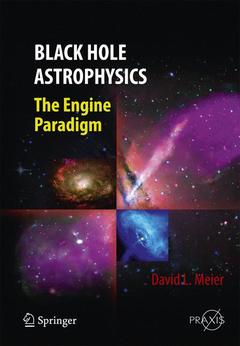Black Hole Astrophysics, 2012 The Engine Paradigm Astronomy and Planetary Sciences Series
Auteur : Meier David L.

As a result of significant research over the past 20 years, black holes are now linked to some of the most spectacular and exciting phenomena in the Universe, ranging in size from those that have the same mass as stars to the super-massive objects that lie at the heart of most galaxies, including our own Milky Way. This book first introduces the properties of simple isolated holes, then adds in complications like rotation, accretion, radiation, and magnetic fields, finally arriving at a basic understanding of how these immense engines work.
Black Hole Astrophysics
? reviews our current knowledge of cosmic black holes and how they generate the most powerful observed pheonomena in the Universe;
? highlights the latest, most up-to-date theories and discoveries in this very active area of astrophysical research;
? demonstrates why we believe that black holes are responsible for important phenomena such as quasars, microquasars and gammaray bursts;
? explains to the reader the nature of the violent and spectacular outfl ows (winds and jets) generated by black hole accretion.
Part I Observations of Black Hole Engines.- 1 Recognizing Black Holes.- 2 Macroquasars: Supermassive Black Holes in the Centers of Galaxies.- 3 Microquasars: Black holes (and Neutron Stars) of Stellar Mass in Our Galaxy.- 4 Miniquasars: Elusive Black Holes of Intermediate Mass.- Part II Physics of Black Hole Engines.- 5 Physics in Everyday Life: A Review of Newtonian Mechanics.- 6 Geometry and Physics Without Gravity: Special Relativity.- 7 Physics in Curved Spacetime: General Relativity and Black Holes.- 8 Four-Dimensional Evolving Geometry: Gravitational Waves and Gravitational Collapse.- 9 Nuts and Bolts of the Black Hole Engine: General Relativistic Mechanics.- Part III Astrophysics of Black Hole Engines.- 10 Assembling the Engine Block: Formation of Black Holes in the Universe.- 11 Fueling and Carburetion: Breakup and Accretion of Stars and Gas Clouds.- 12 The Combustion Chamber: Energy Generation by Gravitational Accretion.- 13 The Thermal Exhaust System: Radiation and Thermally-Driven Winds.- 14 The Non-Thermal Exhaust System I. Rotating Magnetospheres: The Fan that Drives the Turbo-Exhaust System.- 15 The Non-Thermal Exhaust System II. Magnetic Winds and Jets.- 16 Putting it All Together: Black Hole Engines of All Sizes.- Part IV Appendices.- A Mathematical Notation Used in this Book.- B Derivatives of Vectors and Tensors: Differential Geometry.- C Derivation of the Adiabatic Relativistic Stellar Structure Equations.- D Derivation of the General Relativistic MHD Equations from Kinetic Theory.- E Derivation of the General Relativistic Grad-Schlüter-Shafranov Equation.- F Derivation of the Equations for Stationary, Axisymmetric Ideal MHD.- References.
David Meier is a Senior Research Scientist and supervisor of the Evolution of Galaxies Group at Caltech's Jet Propulsion Laboratory in Pasadena, CA. David had an early career doing research in genetics at Washington University School of Medicine and in solid state physics at the University of Missouri - Rolla (UMR), before achieving his goal of research in astrophysics. He was educated in physics at UMR (BS 1971; MS 1973) and in astrophysics at The University of Texas at Austin (MA 1975; PhD 1977), working there under D. Schramm, B. Tinsley, and J.C. Wheeler on astrophysical jet production, galaxy formation, and winds from accretion disks around black holes. In 1976, with Tinsley, he predicted the existence of primeval Lyman break galaxies, which since have been discovered and found to have many of their expected properties. At Caltech and JPL David has been an integral part of a number of projects and missions involving observations of galaxies and black hole systems, including very long baseline radio interferometry (VLBI) in the southern hemisphere, VLBI using a space-based antenna (which created a telescope three times the size of the earth), and the space interferometer mission SIM. He also spent several years working on the US government's “star wars” project and was the group leader for parallel computing applications in that effort. While much of his recent work has been theoretical investigations of accretion inflows and outflows from black holes systems, David also enjoys occasional observational studies, using some of the satellites and telescopes on which he has worked. He also greatly enjoys his three grandsons, with a fourth soon to arrive.
Reviews our current knowledge of cosmic black holes and how they generate the most powerful observed pheonomena in the Universe
Highlights the latest, most up-to-date theories and discoveries in this very active area of astrophysical research
Demonstrates why we believe that black holes are responsible for important phenomena such as quasars, microquasars and gamma-ray bursts
Explains to the reader the nature of the violent and spectacular outflows (winds and jets) generated by black hole accretion
The book is written in a relaxed style, with the level of mathematics used within the text appropriate for final year university students in the USA
Date de parution : 07-2012
Ouvrage de 927 p.
15.5x23.5 cm



